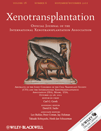Species incompatibilities in the pig-to-macaque islet xenotransplant model affect transplant outcome: a comparison with allotransplantation
Abstract
Graham ML, Bellin MD, Papas KK, Hering BJ, Schuurman H-J. Species incompatibilities in the pig-to-macaque islet xenotransplant model affect transplant outcome: a comparison with allotransplantation. Xenotransplantation 2011; 18: 328–342. © 2011 John Wiley & Sons A/S.
Abstract: Background: Porcine islet transplantation into diabetic non-human primates is considered most relevant in translational research supporting a clinical application. Most studies have focused on immunosuppressive protocols, while metabolic aspects have mainly been utilized in graft monitoring. We evaluated data from our group regarding human and non-human primate (NHP) allotransplantation and pig-to-NHP xenotransplantation to identify incompatibilities in metabolic factors and their consequences for transplant outcomes.
Methods: Basic gluco-metabolic parameters (fasting blood glucose, C-peptide, and response to stimulation with arginine or glucose) were derived from literature (humans), 72 macaques, and 47 adult Landrace pigs. Islet preparations from 15 human deceased donors, 61 macaques, and 23 adult pigs were compared with respect to yield, fractional viability assessed by oxygen consumption normalized for DNA, and in vitro glucose-induced insulin release. Metabolic parameters at day 75 after a single islet transplantation in the liver were compared for 19 patients and 9 macaques receiving an allotransplant and 11 macaques receiving a porcine xenotransplant: recipients received chronic immunosuppression.
Results: Pigs differ from NHPs and humans by a much lower C-peptide level (0.42 vs. 1.3 to 2.0 ng/ml, respectively) and a 2- to 7-fold lower C-peptide response to arginine stimulation. In contrast, NHPs have the highest metabolic demand as evidenced by a high C-peptide and high C-peptide response to arginine stimulation; values are about twice higher than in humans. For manufactured islet preparations, these differences are reflected by glucose-stimulated insulin release (the stimulation index for pigs is 1.5, for humans 3.8, and for macaques 7.7), but not by fractional viability, which was in the same range. The day 75 outcome after transplantation assessed by C-peptide was similar for allotransplanted humans and NHPs (80 to 90% good graft function) and lower in xenografted NHPs (36% good graft function); gluco-metabolic parameters were in accordance with graft function, albeit different between species because normoglycemia under exogenous insulin is maintained more aggressively in patients than in NHPs. In xenografted NHPs, the shift in glycemic control with respect to normal values, combined with low values of circulating porcine C-peptide, resembled more the normal condition in a pig than that in a macaque.
Conclusions: The substantially lower glucose-induced insulin response in adult porcine islet preparations as opposed to islets manufactured from humans or macaques combined with the much higher need for insulin in macaques than in humans creates an imbalance between the metabolic demand and the engrafted islet mass in the pig-to-NHP xenograft recipient. Engrafted islet mass is affected by dose, suggesting that a much higher dose level of islets is necessary in the xenogeneic setting than in human or NHP allotransplantation, and pig islets need to be given at a higher dose in macaques than the anticipated effective dose in humans. To cope with differences in metabolic demand and presumably also metabolic dynamics, a liberal regime in supportive exogenous insulin might be essential to achieve long-term survival. These intrinsic characteristics of the NHP model deserve consideration to optimally design experimental studies with the perspective of translational value of results.




